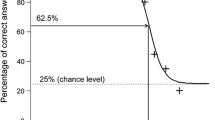Abstract
Four cases with hysterical amblyopia in youngsters under 15-year-old showed the poor reproducibility of visual field, that is, when the same target was moved from the periphery toward the fixation ten times along the same meridian during the same examination, the position of the plotted points were rather variable. The range of variation was measured from the innermost point to the outermost one, after the two first points were omitted because points first detected were usually far from the others. The variation of cases measured by this method was compared with that of normal persons. Results were as follows; 1. in normal person, the mean value of its range was 5.5° in first decade and 4.2° in second to seventh decade; 2. patients with psychogenic visual disturbances showed a variability of 14.2°, and this was significantly different from normal (p < 0.01). These results suggest that this convenient method was helpful for diagnosis of hysteria. It should also be remembered that when we evaluate the visual field, changes under 4° are probably not significant.
Similar content being viewed by others
References
Yasuna ER. Hysterical amblyopia in children and young adults. A M A Arch Ophthal 1951; 45: 70–76.
Schlaegel TF, Quilala FV. Hysterical amblyopia. A M A Arch Ophthal 1955; 54: 875–84.
Harrington DO. Normal visual field; Disturbances of psychogenic origin. In: Harrington DO, ed. The visual fields. Saint Louis: The C.V. Mosby, 1964; 114: 360.
Duke-Elder S, Scott GI. Psychogenic disorders. In: Duke-Elder S, ed. System of Ophthalmology, vol 12. London, Henry Kimpton, 1971; 573–94.
Krill AE. Retinal functional studies in hysterical amblyopia. Amer J Ophthal 1967; 63: 230–7.
Behrman J. The visual evoked response in hysterical amblyopia. Brit J Ophthal 1969; 53: 839–45.
Ellenberger C. Perimetry-principles, technique, and interpretation. New York: Raven Press Books Ltd, 1980.
Kosoko O, Sommer A, Auer C. Duration of automated suprathreshold vs quantitative threshold field examination. Arch Ophthalmol 1986; 104: 398–401.
Jaffe GJ, Alvarado JA, Juster RP. Age-related changes of the normal visual field. Arch Ophthal 1986; 104: 1021–5.
Hamada R, Furuno F, Matsuo H. Morphometric study of the quantitative kinetic perimetry. Acta Soc Ophthal 1981; 85: 1644–54.
Goldmann H. Grundlagen exakter Perimetrie. Ophthalmologica 1945; 109: 57–70.
Liao F. Kinetic and static perimetries in young children. Acta Soc Ophthal Jap 1973; 77: 1270–7.
Honda Y. The standard errors of peripheral visual fields measured at a long interval. Rinsho Ganka 1978; 32: 1323–7.
Parrish II RK, Schiffman J, Anderson DR. Static and kinetic visual field testing. Reproducibility in normal volunteers. Arch Ophthal 1984; 102: 1497–1502.
Author information
Authors and Affiliations
Rights and permissions
About this article
Cite this article
Ohkubo, H. Visual field in hysteria-reliability of visual field by Goldmann perimetry. Doc Ophthalmol 71, 61–67 (1989). https://doi.org/10.1007/BF00155133
Accepted:
Issue Date:
DOI: https://doi.org/10.1007/BF00155133




